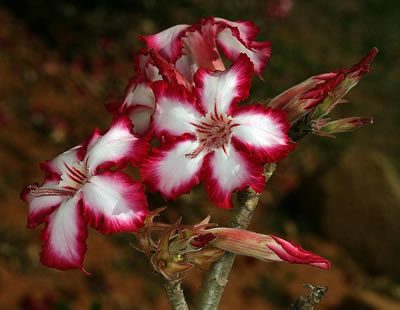The most well-known desert rose from South Africa, the Impala Lily (Adenium multiflorum), also known by this name, is a succulent shrub, ranging from 30cm (about 12 inches) to 3m (about 10 feet) in height. This remarkable plant stands out for its robust and peculiar appearance. Its branches and stem are grey and succulent, and its shape is often compared to that of a miniature baobab (Adansonia digitata). This aspect is an adaptation to the arid conditions of its natural habitat, storing water in the stem and roots to survive in periods of drought.
The sap of the impala lily is milky, a common characteristic in many succulent plants, acting as a defense mechanism against herbivores and infections. The root system is quite robust, a strategy to access underground water resources in its natural environment. The leaves of Adenium multiflorum tend to cluster near the ends of the branches and are usually absent during flowering. This phenomenon is an adaptation to reduce water loss during the dry season.
The flowering of the impala lily occurs in the middle of winter, after a period of dormancy induced by cold and dry weather. This dormancy period is crucial for the flowering of this species, making its cultivation more suitable for subtropical regions. The plant is resistant to dry climates, but sensitive to frost or snow, requiring specific care in colder climate regions.
The flowers of Adenium multiflorum are star-shaped, simple, displaying colors that range from white to pink and red. The most common type has white flowers with a narrow red border, creating a striking visual contrast. Although not as widely cultivated as Adenium obesum, due to its specific requirements for cold, dormancy, shorter flowering period, and slower growth, the impala lily is valued among collectors and succulent plant enthusiasts.
Hybrids of Adenium multiflorum are known for their sparse flowering but can offer a variety of colors and shapes. This characteristic makes them particularly attractive for the development of new ornamental varieties.
Unfortunately, the impala lily faces significant threats in its natural habitat. The plant is often targeted by collectors due to its beauty and uniqueness, which, along with habitat degradation for pasture formation, places it at risk. It is currently listed as an endangered species. It is crucial that conservation efforts be implemented to preserve this unique species, both in its natural habitat and in botanical collections and private gardens.
To successfully cultivate the impala lily (Adenium multiflorum), it is essential to understand its specific requirements, reflecting its natural habitat in South Africa. Firstly, it’s important to ensure well-drained soil, as moisture accumulation can lead to root rot. A desert rose soil mix, or even one for cacti and succulents, allowing for rapid water drainage, is ideal. In terms of lighting, this plant requires high brightness, preferring direct sunlight for at least 6 hours a day. This stimulates healthy growth and abundant flowering. In equatorial climates, it is advisable to protect it during the hottest hours of the day, with a shade cloth or other filtered cover.
Regarding watering, the impala lily requires a cautious approach. During the growing season, watering should be regular, allowing the soil to dry out partially between waterings. However, in winter, when the plant enters its dormancy period, watering should be drastically reduced. This watering cycle mimics the natural conditions of drought and seasonal rains to which the plant is adapted in its habitat. Never use a saucer under the pot, thus preventing the roots from becoming waterlogged. Similarly, repot annually to renew the substrate, preventing its compaction.
Temperature is another critical factor for the cultivation of Adenium multiflorum. Although the plant is resistant to dry climates, it does not tolerate intense cold, prone to snow or frosts. Temperatures below 50°F (10°C) can be harmful, so in regions with cold winters, it is advisable to cultivate the impala lily in pots that can be moved to protected environments during the winter.
Finally, fertilization is an important aspect of cultivation. During the growing season, the application of a balanced fertilizer, specially formulated for desert roses, with high potassium content, can promote vigorous growth and spectacular flowering. Fertilization should be reduced or stopped during the dormancy period in winter. It multiplies by seeds or by cutting of the branches. Remember that only plants formed by seeding develop a caudex, while those multiplied by cutting can acquire beautiful forms but not a true caudex.




